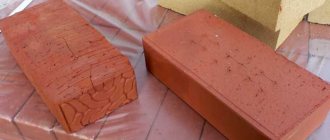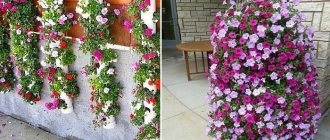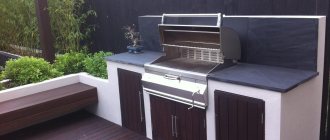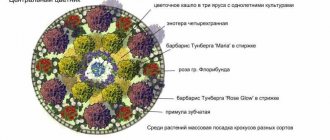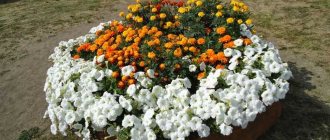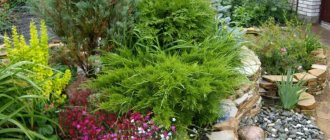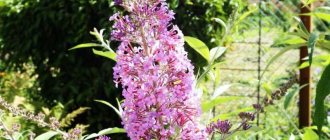If you live in a private house or have a dacha outside the city, then the issue of landscaping the local area is especially relevant for you. Since ancient times, flowers have been considered the best decoration. Anyone can arrange a flower bed or decorate a flower garden. It's not as difficult as it seems at first glance.
What is the difference between these elements of landscape design? For a flower garden, the shape is not important; it can be very diverse. But the flowerbed requires strict adherence to geometry; it can have the shape of a circle, rectangle, or square. And unlike a flower garden, it is always located in the open ground.
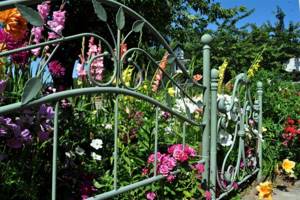
In this article we will look at how to make a beautiful flower bed on your site with your own hands.
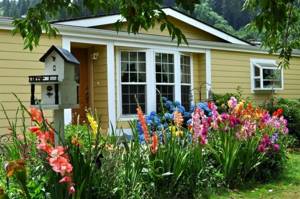
Rules you need to know
The flowerbed must be organically integrated into the surrounding landscape, otherwise it will look ridiculous. It is optimal to combine annual and perennial plants, as well as plants with different beginnings and flowering periods.
Plants must be combined in height. First, ground cover should be planted, then low-growing, medium-growing and tall.
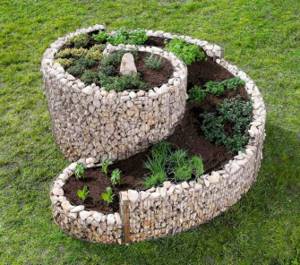
The shape of the flower bed depends on the architecture of the landscape. It can be trapezoidal, square, pyramidal, triangular, rectangular.
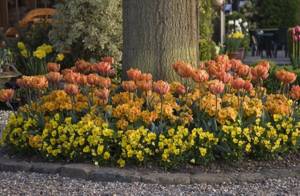
When choosing flowers for a flower bed, you need to take into account your own wishes and preferences.
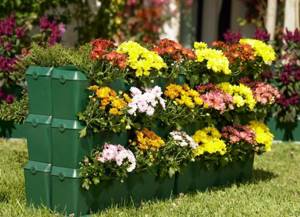
Do not forget about the competent selection of the color palette of the composition. Warm tones visually bring you closer, while cold tones move you away. Harmoniously selected tones and shades add aesthetics to the flowerbed.
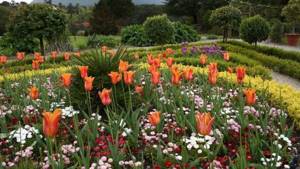
Ring flower bed
It differs from an ordinary flower bed in that it encircles an object - a tree, a monument, a gazebo, etc.
It is especially popular now to arrange such flower beds, placing a beautiful vase of flowers or an interesting sculpture in the center. Plants in such a flowerbed are planted by selecting their height: tall ones are placed along the inner radius of the circle, and low ones are placed along the outer radius. Thus, the object forms a kind of pedestal of flowering plants.
Advice. Flower plants in a flower bed can be arranged in different ways. If any pattern is created from them, then plants of the same height are selected. In round flower beds, the view of which is accessible from all sides, taller flowers are usually planted in the center, and lower flowers are planted towards the edges.
Types of flower beds
Flowerbeds are divided into:
Carpets. They have a square or rectangular shape and are usually planted with low flowers. This is a popular decoration for parks and gardens.
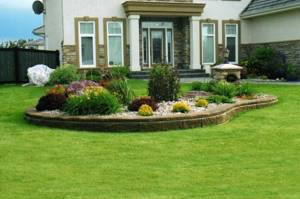
Irregular. Some flowers replace others, that is, plants bloom at different times.

Regular. All plants have the same onset and duration of flowering.
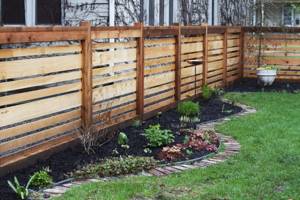
Monofloral flower beds. The simplest option. Flowers of the same type and variety are planted. The rosary belongs to this type.

Traditional. They are an ordinary bed dotted with plants, and when some finish blooming, others begin to bloom. In other words, continuous flowering is the main feature of this type of flower bed.
Chameleon. This flowerbed is similar to the traditional one, but there is one difference - a play of contrasts. Flowers have different colors and the change of tones occurs abruptly.

Vertical. Used for decorating gazebos, arches, fences, retaining walls, etc.

Ring. Designed to frame individual elements of garden design, be it a fountain, a sculptural group, a bush or a tree.
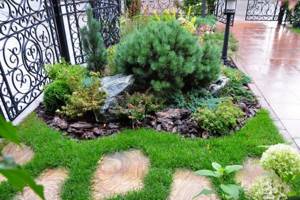
Floating. Used to decorate an artificial pond.
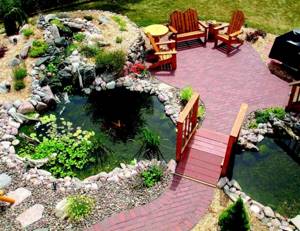
Hanging. They are based on wicker baskets. This is the perfect decor for a gazebo or patio.
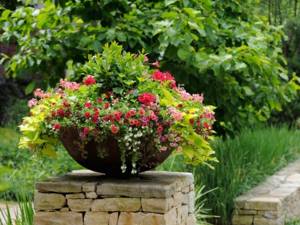
Separately, it should be noted:
Alpine slides. These are flower beds located on hills and planted with low perennials. Additionally, it is possible to use stones of different sizes as a base for planting flowers.
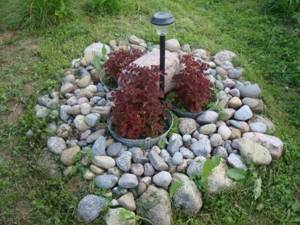
Border. This type of flower bed is used to frame paths and platforms.
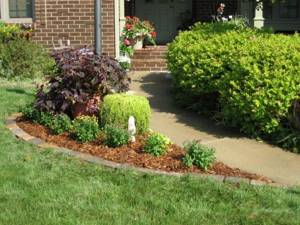
Flowerpot. This is a special type of flower bed, with which you can plant trees in those places where it is not possible to plant a flower arrangement of another type.
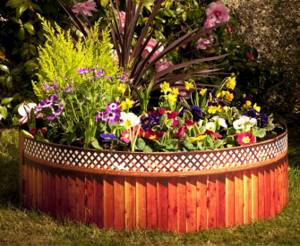
Multidimensional flower beds. To create them, landscape stylists use additional objects.
Flowerbeds and borders, Types of flowerbeds
Regular flower bed.
Its distinctive feature is a strict geometric pattern of plants. It is easily discernible when using simple, symmetrical shapes, but is much less obvious in the intricacies of abstract shapes. Two distinctive features:
A. All plants should bloom at the same time. b. The presence of clear boundaries between plantings, emphasizing the absence of any traces of naturalness in a regular flowerbed.
Irregular flower bed.
Plants are planted in small groups as hardy perennials in a herbaceous border. The flowerbed looks more natural. Planting zones for different plants overlap.
The design of the flower bed is done so that the flowering of one group follows another. This allows for longer flowering. It is possible to create a flower bed with subtropical plants
.
raised flower bed
- the best option. It is truly part of the garden and can be large enough to create an impressive arrangement of bedding plants.
carpet flower bed
- a method of planting dwarf plants with colored foliage, as a result of which complex patterns are formed, reminiscent of the ornament of an oriental carpet. These are very decorative flower beds, caring for them is extremely labor-intensive. Such flower beds have practically ceased to be planted. Although sometimes they are still found in urban landscaping.

Monoflowers
- the entire flowerbed or border is planted with plants of the same type.
Vertical flower bed
- three-dimensional flower bed. Used at exhibitions or in urban landscaping as an exclusive element.
Often the decorative design of flower beds is made in the form of some kind of figure or “wall”. It is possible to make such a screen in your garden.
Flowerbed-panel
- a decorative element used mainly in urban landscaping.
In a flowerbed-panel, a variety of low-growing plants are used to create not an ornament, but a specific image. Along with ornamental plants, flowering flowerbed plants
.
As an example, we can cite the Luzhniki flower beds, the world famous Geneva flowerbed clock, and the clock at the zoo in Chester.
Many of our clients have asked if we can make it so that: - creating flower beds becomes a simpler and easier process; - don’t rack your brains over what to plant in the flowerbed and how to decorate it; — literally in 1-2 days a blooming flowerbed appeared from scratch.
And so the designers of the “Noble Garden” have developed special offers:
Ready-made solutions for landscape design
This is a kind of kit consisting of: - a set of flowerbed plants, - specially selected soil in the required volume, - material for decorating a flowerbed and other necessary components.
How to properly plant a flowerbed yourself
Prepare the site. Its level should be higher than the sidewalk level. Achieve elevation by making a mound of the desired size.
Give the site the required shape. A cord will help you make a circle, and a regular tape measure will help you make a square or rectangle.
If desired, you can build a fence from bricks or irregularly shaped stones.

Plant the plants selected in advance. First, plant those of them that are assigned the role of central figures (no more than 3 - 5 pieces). These can be perennials, evergreens, bushes and even small trees. Then plant the rest around them. Remember, low plants are usually planted along the edges of the flower bed.

Framing flower beds
Most often, a flower bed should have clear boundaries. This gives it compositional completeness, and also protects it from growth, penetration of unnecessary plants (lawn grass, weeds) and washing out of the soil during watering or rain.
Decorating the edge of a flower bed can be done using various materials. Their choice will depend on the type of flower garden; they should fit organically into the overall design of the summer cottage.
First, the turf layer should be removed along the perimeter of the flowerbed and a small groove (about 10 cm) should be dug, which should be filled with broken brick, crushed stone or other similar material. Then, on this basis, you should make a fence. These can be various fences made of metal, wood, wicker, plastic, placed on the corner of a brick. Fences for flower beds made of natural or artificial stone are very beautiful. Or you can simply decorate the border with any decorative filling (colored chips, crushed stone, pebbles and others).
To decorate the edges of flower beds in the country, some gardeners create fences from waste material - plastic or glass bottles, old car tires. When done carefully and with love, this finish can be quite pretty. But when painting fences, don’t get carried away with bright colors, they will distract attention.
For a raised flowerbed, a ditch of about 30 cm is dug, gravel or sand is poured onto the bottom and filled with cement mortar, and brick or stone masonry is made on this foundation. An original modern solution is to use small gabions as walls for such a flower bed.

Low-growing or ground cover plants can also serve as a frame. A clear small border of alyssum, heuchera, sage, seaside cineraria, delphinium lavender, and Carpathian bluebell will make a beautiful transition from the flower garden to the grassy greenery of the lawn. Lungwort borders and brunners are good for shady places.
Recommendations
Landscape decorators give the following recommendations for creating a flowerbed with your own hands:
- You should not choose flowers for your flower bed thoughtlessly. They must be combined with each other.
- The most popular are flower beds with regular geometric shapes, since they are easier to fit into the existing landscape.
- When designing this type of flower garden, you need to take into account the configuration of architectural structures in the local area.
- The flowerbed should only be placed in an area where there is a suitable background for it.
- To create a flower bed, it is best to opt for low-maintenance flowers.
- Before you get down to business, you need to think through a clear procedure. This will help avoid mistakes.

raised flower bed
Recently it has become extremely popular. It is named so because it is not located on the ground, but in special containers raised above the ground to a height of 20 cm and above. This method of arranging flower beds allows, firstly, to plant flowers in places where this cannot be done in the usual form, for example, to frame stairs, on poor or saline soils, in places where various communications pass or very dense buildings. Secondly, being an expressive design element, they allow you to escape from the ordinary and create something new and interesting.
The shape of raised flower beds can be different, as well as the material used to make the walls. This flower bed is very versatile and will be appropriate in any garden.
Plants in raised beds are much easier to care for. The only thing you need to remember all the time is that the soil dries out much faster than in ordinary flower beds, therefore, watering must be done more often.
In addition, plants in raised beds develop better and bloom faster, since they are not afraid of frost on the soil, the soil warms up faster, is well ventilated, and there is no stagnation of water. And there are much fewer pests in such flower beds.
Raised flower beds should be planted with plants that can provide them with decorative value for a long time, and you can choose flowers of 2-3 types, or just one. Flowers such as petunia, nasturtium, zonal pelargonium, lobelia, etc. look good in small flower beds or vases. Ornamental grasses are very good in large flower beds, especially terraced ones.
In highly raised flower beds (more than 50 cm), perennial plants usually freeze out in winter, so it is better to use annuals to decorate them. A drainage layer of gravel or pebbles is placed at the bottom of the flowerbed.
Advice. In a small area, a raised flowerbed will allow you to decorate the garden without taking up much space, and in a large garden, made in the form of terraces, it will not only visually expand the boundaries of the area, but will give it an interesting volume.
Popular design for flower beds
The photo of do-it-yourself flower beds clearly shows that they can be made from:
Old things. This could be an old tank, bathtub, sink, toilet, shoes. You just need to paint them in rich, cheerful shades.
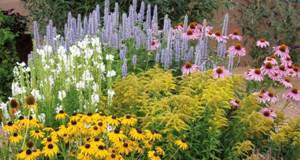
Car tires. It’s easy to make an unusual, beautiful flower bed out of them - you just need to cut off the side of the tire. You need to fill the resulting container with soil and plant plants in it.
Antique-style wheelbarrows and carts. Such flower beds add a rural ambiance to the setting.

Bicycle. This composition looks very interesting.
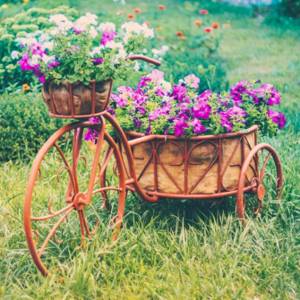
Out-of-fashion furniture. By combining flowers and individual pieces of furniture, you can create a real masterpiece of landscape craftsmanship. Such compositions look very original and stylish.

Use your imagination, don’t be afraid to experiment, and you can create not just a flowerbed, but a work of art that will become the source of your pride and the envy of your neighbors.
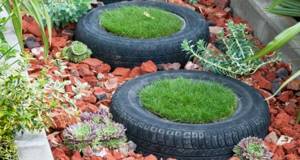
Vertical flower bed
Most often, a vertical flower bed is used in urban landscaping, but if desired, it can be made on any site as a kind of volumetric screen that will highlight a cozy corner in the garden or disguise something unsightly. To set up such a flower bed, you need a strong frame on which flowerpots with plants are attached floor by floor. The result is a continuous column of flowers, which will be even more beautiful when using hanging plants.
Depending on the frame used for the vertical flower bed, you can get any shape (animal, fairy-tale character, geometric shape, etc.).
DIY photo of flower beds
Flowerbed chameleon
Outwardly, it does not differ from an ordinary traditional flower bed, but the plants planted on it are selected in such a way that it changes its color depending on the timing of flowering. It’s not difficult to choose such combinations; you just need to know the flowering time of the planted plants. For example, in the fall, daffodils are planted on a flowerbed, which in the spring will cover it with a snow-white cloud (or yellow, depending on the variety), in the spring, after the frosts have passed, pink petunia with grown seedlings (by the way, it can also be planted with flowers), and the flowerbed will change your color. In order for petunia to bloom immediately after the daffodils bloom, it is sown as seedlings in the second decade of March.
How to choose the shape of a flower bed?
The architectural style of the house, especially old houses, dictate certain rules and forms for flower beds.
The traditional standard home is often associated with strict symmetry. Flowerbeds are created in a classic geometric shape, repeating the straight lines of the house or softening the regular shapes with eco-design that imitates corners of the wild.
Modern houses come in a variety of styles, especially those built to individual designs. The buildings are distinguished by facade materials, which can be emphasized by the correct selection of palette and type of plants. This makes it possible to personalize the landscape.
The choice of design is based on a favorite shape or repetition of the space or lines of the façade. For example, if you like circle-shaped garden beds, there are ways to incorporate such a flower garden into the overall design. The actual shape often becomes the basis for choosing a flower bed design. Some octagonal-shaped houses with bay windows or curved walls can be accentuated by creating a unique flower garden in the yard.
Geometric flower beds
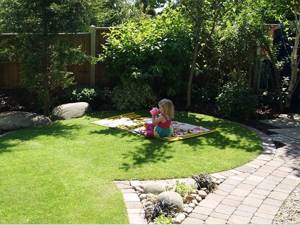
Geometric flower beds are created in the form of rectangles, circles and polygons that can be repeated. Planting areas can be segmented or arranged in a grid. The circles are divided and organized into lines or arcs of colors. Geometrically correct shapes are considered a classic style.
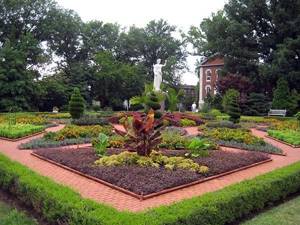
Naturalistic forms are created in maximum similarity to natural conditions and implemented in an arbitrary manner. The emphasis is on the arrangement of colors as naturally as possible. Plants are surrounded by rocks, streams, and flower beds have various shapes, such as winding lines.
Arrangement rules
To achieve a good result when decorating flower beds, you should follow some rules.
- Placement planning. Flower beds and flower beds should fit harmoniously into the existing landscape. It would be nice to make a sketch of the project to visually represent the result.
- Maintaining integrity. Flowerbeds should match each other or have a decorative element that unites their different types.
- Compliance with multi-tiers. Tall plants should be planted in the center, and shorter plants should be planted at the edges. There should be enough light for everyone.
- Flowers are planted so that they “look” at the sun.
- You need to leave a distance between the flowers - this will help them develop normally.
- Plants are planted most densely along the edges. Closer to the center, the landing density should weaken.
- It is advisable to build flower beds in easily visible places.
- Properly selected fencing will make caring for flower beds easier. Thanks to the borders, the grass will not spread into the flower beds.
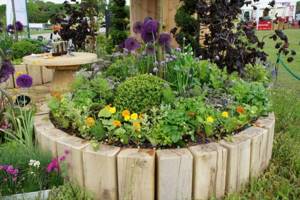
Original ideas for designing flower beds
If you want to approach the process of designing a flower bed more creatively, check out the original flower bed ideas selected by our authors. Flowers can be placed in:
- tires
- banks
- buckets and watering cans
- suitcase
- wooden boxes
- stumps and hollow tree trunks
- old plumbing
- furniture
The “spilled” flower bed looks the most original. To create it you need a flower pot or jug and the plants themselves. The vessel is filled with earth and laid on its side, and flowers are planted nearby in the form of a flowing stream.

Tire flower beds
This is probably the most common design option for flower beds. They create flower beds from tires, which are usually damaged and therefore no longer used for their intended purpose.
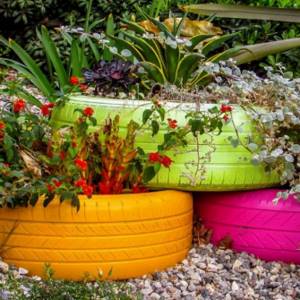
Tires need to be washed and painted well. Sand is poured into the recess of the tire and flowers are placed there. The most creative summer residents use cuts to make different figures from tires: a swan, a frog, a hare.
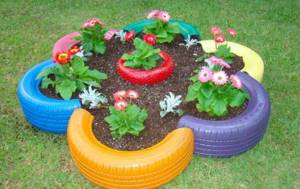
Wooden flower beds
Even a novice master can do this. Wood can be used of any type:
- round chocks;
- board scraps;
- block house (boards convex on one side only);
- pegs;
- wicker fences.

The disadvantage is that wood is susceptible to moisture. Without treatment with protective impregnation, such a fence will not retain its appearance for long. Then it will have to be restored.
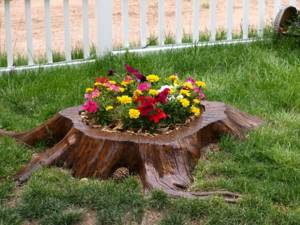
Note!
- Perennial flowers for the garden: beautiful ideas, unpretentious and long-blooming one after another, a list for the lazy, types for the garden (140 photos)
- Brick flower beds (130 photos): types of flower beds, how to lay them correctly, where to start, ideas
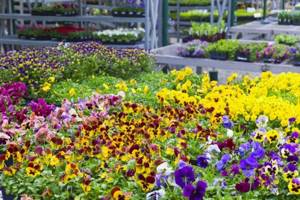
Low-growing flowers for a flower bed: varieties of flowers for the garden that bloom all summer, types and characteristics, (125 photo examples)
Bottle flowerbeds
Surely everyone in the house has unnecessary bottles after some particularly significant event. Usually the fence is made from plastic one and a half liter bottles. It's very simple. You just need to dig them in with their necks down. You will get a kind of fence. The bottles are pre-painted in the desired color.
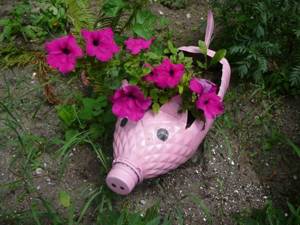
Note!

Do-it-yourself flower garden: mistakes of novice gardeners, simple and complex flower beds, near the house, in the country, for flowers (145 photo ideas)
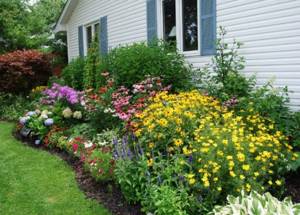
Blooming flower bed: options for their use, planting schemes, on the site, near the house, creating a beautiful flower bed (150 photo schemes)
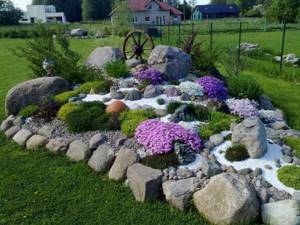
Flowerbed made of stones - modern projects, how to make it correctly, step-by-step instructions on how to make it yourself (145 photo ideas)
Tip: for better strengthening, fill each bottle with sand.
